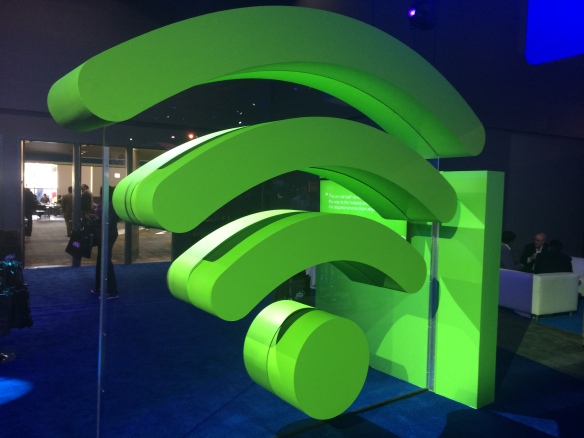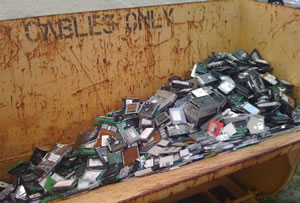Author Archives: networkingnerd
Author Archives: networkingnerd

Peyton Maynard-Koran was the keynote speaker at InteropITX this year. If you want to catch the video, check this out:
Readers of my blog my remember that Peyton and I don’t see eye-to-eye on a few things. Last year I even wrote up some thoughts about vendors and VARs that were a direct counterpoint to many of the things that have been said. It has even gone further with a post from Greg Ferro (@EtherealMind) about the intelligence level of the average enterprise IT customer. I want to take a few moments and explore one piece of this puzzle that keeps being brought up: You.
You are a critical piece of the IT puzzle. Why? You’re a thinking person. You can intuit facts and extrapolate cause from nothing. You are NI – natural intelligence. There’s an entire industry of programmers chasing what you have. They are trying to build it into everything that blinks or runs code. The first time that any company has a real breakthrough in true artificial intelligence (AI) beyond complicated regression models will be a watershed day for us all.
However, you are also the problem. You have requirements. You need a Continue reading

I’ve had some fascinating networking discussions over the past couple of weeks at Dell Technologies World, Interop, and the spring ONUG meeting. But two of them have hit on some things that I think need to be addressed in the industry. Both Russ White and Ignas Bagdonas of the IETF have come to me and talked about how they feel networking professionals have lost sight of the basics.
If you walk up to any network engineer and ask them to explain how TCP works, you will probably get a variety of answers. Some will try to explain it to you in basic terms to avoid getting too in depth. Others will swamp you with a technical discussion that would make the protocol inventors proud. But still others will just shrug their shoulders and admit they don’t really understand the protocol.
It’s a common problem when a technology gets to the point of being mature and ubiquitous. One of my favorite examples is the fuel system on an internal combustion engine. On older cars or small engines, the carburetor is responsible for creating the correct fuel and air mixture that is used to power the cylinders. Getting that Continue reading

One of the more exciting things I saw at Dell Technologies World this week was the announcement by VMware that they are supporting Microsoft Azure now in additional to AWS. It’s interesting because VMware is trying to provide a proven, stable migration path for companies that are wanting to move to the cloud but still retain their investments in VMware and legacy virtualization. But is offing legacy transition a good idea?
If I were to mention VLAN 1002-1005 to networking people, they would likely jump up and tell me that I was crazy. Because those VLANs are not valid on any Cisco switches save for the Nexus line. But why? What makes these forbidden? Unless you’re studying for your CCIE you probably just know these are bad and move on.
Turns out, they are a legacy transition mechanism from the IOS-SX days. 1002 and 1004 were designed to bridge FDDI-to-Ethernet, and 1003 and 1005 did the same for Token Ring. As Greg Ferro points out here, this code was tightly bound into IOS-SX and likely couldn’t be removed for fear of breaking the OS. The reservation continued forward in all IOS branches except Continue reading

So, I recently went to my first RSA Conference. It’s something I’ve had on my radar for a while but never had the opportunity to do. However, with Security Field Day coming up later this year I thought it was high time I went to see what everything was about. Here are some ideas that I came up with during my pilgrimage to the big security conference.

Breaking into an industry isn’t easy. When you look at the amount of material that is necessary to learn IT skills it can be daunting and overwhelming. Don’t let the for-profit trade school ads fool you. You can’t go from ditch digger to computer engineer in just a few months. It takes time and knowledge to get there.
However, there is one concept in non-technical job roles that feels very appropriate to how we do IT training, specifically for security. And that’s the apprenticeship.
Apprenticeship is a standard for electricians and carpenters. It’s the way that we train new people to do the work of the existing workforce. It requires time and effort and a lot of training. But, it also fixes several problems with the current trend of IT certification:
I used to work with a guy that would configure servers for us and always include an extra SCSI card in the order. When I asked him about it one day, he told me, “I left it out once and it delayed the project. So now I just put them on every order.” Even after I explained that we didn’t need it over and over again, he assured me one day we might.
Later, when I started configuring networking gear I would always set a telnet password for every VTY line going into the switch. One day, a junior network admin asked me why I configured all 15 instead of just the first 5 like they learn in the Cisco guides. I shrugged my shoulders and just said, “That’s how I’ve always done it.”
There’s no more dangerous phrase than “That’s the way it’s always been.”
Time and time again we find ourselves falling back on the old rule of thumb or an old working configuration that we’ve made work for us. It’s comfortable for the human mind to work from a point of reference toward new things. We find ourselves doing it all Continue reading

Hopefully by now you’ve seen the announcement that CloudFlare has opened a new DNS service at the address of 1.1.1.1. We covered a bit of it on this week’s episode of the Gestalt IT Rundown. Next to Gmail, it’s probably the best April Fool’s announcement I’ve seen. However, it would seem that the Internet isn’t quite ready for a DNS resolver service that’s easy to remember. And that’s thanks in part to the accumulation of bad address hygiene.
The address range of 1/8 is owned by APNIC. They’ve had it for many years now but have never announced it publicly. Nor have they ever made any assignments of addresses in that space to clients or customers. In a world where IPv4 space is at a premium, why would a RIR choose to lose 16 million addresses?
As it turns out, 1/8 is a pretty bad address space for two reasons. 1.1.1.1 and 1.2.3.4. These two addresses are responsible for most of the inadvertent announcements in the entire 1/8 space. 1.2.3.4 is easy to figure out. It’s the most common example IP address Continue reading
I just got back from Aruba Atmosphere this week and I thought it would be a good chance to go over some of the cool stuff that I saw there.

Hopefully, you’ve had a chance to watch this 7 minute video from Greg Ferro about why better patching systems can lead to insecure software. If you haven’t, you should:
Greg is right that moral hazard is introduced because, by definition, the party providing the software is “insured” against the risks of the party using the software. But, I also have a couple of issues with some of the things he said about tech support.
I’ve been working with some Ubiquiti access points recently. So far, I really enjoy them and I’m interested to see where their product is going. After doing some research, the most common issue with them seems to be their tech support offerings. A couple of Reddit users even posted in a thread that the lack of true enterprise tech support is the key that is keeping Ubiquiti from reaching real enterprise status.
Think about all the products that you’ve used over the last couple of years that offered some other kind of support aside from phone or rapid response. Maybe it was a chat window on the site. Maybe it was an asynchronous email system. Hell, if you’ve ever installed Continue reading

Networking and systems professionals preach the value of redundancy. When we tell people to buy something, we really mean “buy two”. And when we say to buy two, we really mean buy four of them. We try to create backup routes, redundant failover paths, and we keep things from being used in a way that creates a single point of disaster. But, what happens when something we’ve worked hard to set up causes us grief?
The first problem I ran into was one I knew how to solve. I was installing a new Ubiquiti Security Gateway. I knew that as soon as I pulled my old edge router out that I was going to need to reset my cable modem in order to clear the ARP cache. That’s always a thing that needs to happen when you’re installing new equipment. Having done this many times, I knew the shortcut method was to unplug my cable modem for a minute and plug it back in.
What I didn’t know this time was that the little redundant gremlin living in my cable modem was going to give me fits. After fifteen minutes of not getting the system to come Continue reading

As you may have heard by now, there have been a few exciting announcements from Cisco Live 2018 regarding the venue for the customer appreciation event and the closing keynote speakers.
The first big announcement is the venue for the CAE. When you’re in Orlando, there are really only two options for the CAE. You either go to the House of the Mouse or you go to Universal Studios. The last two times that Cisco Live has gone to Orlando it has been to Universal. 2018 marks the third time!
Cisco is going big this year. They’ve rented the ENTIRE Universal Studios park. Not just the backlot. Not just the side parks. They WHOLE thing. You can get your fix on the Transformers ride, visit Harry Potter, or even partake of some of the other attractions as well. It’s a huge park with a lot of room for people to spread out and enjoy the scenery.
That’s not all. The wristband that gets you into the CAE also gets you access to Islands of Adventure before the full park opens! You can pregame the party by hanging out at Hogwarts, going to Jurassic Park, or joining your Continue reading

In case you haven’t heard, there’s a new vector for Distributed Denial of Service (DDoS) attacks out there right now and it’s pretty massive. The first mention I saw this week was from Cloudflare, where they details that they were seeing a huge influx of traffic from UDP port 11211. That’s the port used by memcached, a database caching system.
Surprisingly, or not, there were thousands of companies that had left UDP/11211 open to the entire Internet. And, by design, memcached responds to anyone that queries that port. Also, carefully crafted packets can be amplified to have massive responses. In Cloudflare’s testing they were able to send a 15 byte packet and get a 134KB response. Given that this protocol is UDP and capable of responding to forged packets in such a way as to make life miserable for Cloudflare and, now, Github, which got blasted with the largest DDoS attack on record.
How can you fix this problem in your network? There are many steps you can take, whether you are a system admin or a network admin:

Wireless is a complicated thing. Even when you try to distill it down to networking basics on the wired side of the access point, you still have a very hard problem to solve on the radio side. Even I’ve talked in the past about how wireless is now considered a “solved” problem. But, the more I interact with wireless professionals and the more I think about the problem, the issue isn’t that IT departments think wireless is solved, it’s that they don’t appreciate the value of a specialist.
There’s an old joke that goes, “What do you call the person that graduated last in their medical school class? Doctor.” Professionals spend a lot of their time learning a tradecraft and practicing it to get better. And it’s not just doctors. So do plumbers, electricians, and teachers. Anyone that has ever tried to do any of these trades will tell you that the basics are capable of being figured out by the average non-professional, but the details are a huge leap.
You’d never assume that being able to put on a Band-Aid on a scrape would qualify you to do brain surgery. Or that changing a Continue reading

Technology always marches on. People want to see the latest gadgets doing amazing things, whether it be flying electric cars or telepathic eyeglasses. Our society is obsessed with the Jetsons and the look of the future. That’s why we’re developing so many devices to help us get there. But it’s time for IT to reconsider how they are using one of them for a purpose far from the original idea.
By all accounts, the Amazon Echo is a masterful device. It’s a smart speaker that connects to an Amazon service that offers you a wider variety of software programs, called skills, to enhance what you can do with it. I have several of these devices that were either given out as conference attendance gifts or obtained from other giveaways.
I find the Echo speaker a fascinating thing. It’s a good speaker. It can play music through my phone or other Bluetooth-connected devices. But, I don’t really use it for that purpose. Instead, I use the skills to do all kinds of other things. I play Jeopardy! frequently. I listen to news briefings and NPR on a regular basis. I get weather forecasts. My son uses Continue reading

Some quick thoughts on networking from my last couple of weeks at Networking Field Day 17 and Tech Field Day Extra at Cisco Live Europe:

I’m soon to depart from Cisco Live Barcelona. It’s been a long week of fun presentations. While I’m going to avoid using the words intent and context in this post, there is one thing I saw repeatedly that grabbed my attention. ACI is eating Cisco’s world. And it’s coming for something else very soon.
Application-Centric Infrastructure has been out for a while and it’s meeting with relative success in the data center. It’s going up against VMware NSX and winning in a fair number of deals. For every person that I talk to that can’t stand it I hear from someone gushing about it. ACI is making headway as the tip of the spear when it comes to Cisco’s software-based networking architecture.
Don’t believe me? Check out some of the sessions from Cisco Live this year. Especially the Software-Defined Access and DNA Assurance ones. You’re going to hear context and intent a lot, as those are the key words for this new strategy. You know what else you’re going to hear a lot?
Contract. Endpoint Group (EPG). Policy.
If you’re familiar with ACI, you know what those words mean. You see the parallels between the data center Continue reading

During Networking Field Day 17, there was a lot of talk about legacy IT constructs, especially as they relate to the cloud. Cloud workloads are much better when they are new things with new applications and new processes. Existing legacy workloads are harder to move to the cloud, especially if they require some specific Java version or special hardware to work properly.
We talk a lot about how painful legacy IT is. So why do we turn it into a monument that spans the test of time?’
Most monuments that we have from ancient times are things that we never really intended to keep. Aside from the things that were supposed to be saved from the beginning, most iconic things were never built to last. Even things like the Parthenon or the Eiffel Tower. These buildings were always envisioned to be torn down sooner or later.
Today, we can’t imagine a world without those monuments. We can’t conceive of a time without them. And, depending on Continue reading

I don’t know if you’ve had a chance to see this Reddit thread yet, but it’s a funny one:
We eliminated routing protocols from our network!
Short non-clickbait summary: We deployed SD-WAN and turned off OSPF. We now have a /16 route for the internal network and a default route to the Internet where a lot of our workloads were moved into the cloud.
Bravo for this networking team for simplifying their network to this point. All other considerations aside, does this kind of future really bode well for SD-WAN?
As pointed out in the thread above, the network team didn’t really get rid of their dynamic routing protocols. The SD-WAN boxes that they put in place are still running BGP or some other kind of setup under the hood. It’s just invisible to the user. That’s nothing new. Six years ago, Ivan Pepelnjak found out Juniper QFabric was running BGP behind the scenes too.
Hiding the networking infrastructure from the end user is nothing new. It’s a trick that has been used for years to allow infrastructures to be tuned and configured in such a way as to deliver maximum performance without letting anyone tinker Continue reading

We’re surrounded by technical debt every day. We have a mountain of it sitting in distribution closets and a yard full of it out behind the data center. We make compromises for budget reasons, for technology reasons, and for political reasons. We tell ourselves every time that this is the last time we’re giving in and the next time it’s going to be different. Yet we find ourselves staring at the landscape of technical debt time and time again. But how can we start chipping away at it?
You may think you don’t have any time to work on the technical debt problem. This is especially true if you don’t have the time due to fixing problems caused by your technical debt. The hours get longer and the effort goes up exponentially to get simple things done. But it doesn’t have to be that way.
Every minute you spend trying to figure out where a link goes or a how a server is connected to the rest of the pod is a minute that should have been spent documenting it somewhere. In a text document, in a picture, or even on the back of a Continue reading

Welcome back to a year divisible by 2! 2018 is going to be a good year through the power of positive thinking. It’s going to be a fun year for everyone. And I’m going to do my best to have fun in 2018 as well.
Per my tradition, today is a day to look at what is going to be coming in 2018. I don’t make predictions, even if I take some shots at people that do. I also try not to look back to heavily on the things I’ve done over the past year. Google and blog searches are your friend there. Likely as not, you’ve read what I wrote this year and found one or two things useful, insightful, or amusing. What I want to do is set up what the next 52 weeks are going to look like for everyone that comes to this blog to find content.
The past couple of years has shown me that the written word is starting to lose a bit of luster for content consumers. There’s been a bit push to video. Friends like Keith Townsend, Robb Boardman, and Rowell Dionicio have started making more video Continue reading